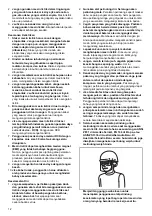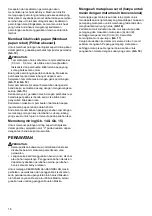
9
For the correct planer blade setting
Your planing surface will end up rough and uneven, unless the blade is set properly and securely. The blade must be
mounted so that the cutting edge is absolutely level, that is, parallel to the surface of the rear base.
Below are some examples of proper and improper .
Connecting a vacuum cleaner (Fig. 8)
NOTE:
• In some countries, the nozzle may not be included in
the tool package as standard accessory.
For tool with nozzle
Connect a hose of the vacuum cleaner to the nozzle.
For tool without nozzle
1. Remove the chip cover from the tool.
2. Install the nozzle on the tool using the screws.
3. Connect a hose of the vacuum cleaner to the nozzle.
Nozzle cleaning
Clean the nozzle regularly.
Use a compressed air to clean the clogged nozzle.
OPERATION
WARNING: To reduce the risk of injury to persons,
do not operate without nozzle or chip cover in place.
CAUTION:
• Hold the tool firmly with one hand on the knob and the
other hand on the switch handle when performing the
tool.
Planing operation (Fig. 9)
First, rest the tool front base flat upon the workpiece
surface without the blades making any contact. Switch on
and wait until the blades attain full speed. Then move the
tool gently forward. Apply pressure on the front of tool at
the start of planing, and at the back at the end of planing.
Planing will be easier if you incline the workpiece in
stationary fashion, so that you can plane somewhat
downhill.
The speed and depth of cut determine the kind of finish.
The power planer keeps cutting at a speed that will not
result in jamming by chips. For rough cutting, the depth of
cut can be increased, while for a good finish you should
reduce the depth of cut and advance the tool more slowly.
Shiplapping (Rabbeting) (Optional
accessory)
To make a stepped cut as shown in the figure, use the
edge fence (guide rule).
(Fig. 10)
CAUTION:
• The blade edge should be made to protrude outside
slightly (0.3 mm - 0.6 mm). Otherwise, nicks and
generally poor shiplapping results.
Draw a cutting line on the workpiece. Insert the edge
fence into the hole in the front of the tool. Align the blade
edge with the cutting line.
(Fig. 11 & Fig. 12)
Adjust the edge fence until it comes in contact with the
side of the workpiece, then secure it by tightening the
screw.
(Fig. 13)
When planing, move the tool with the edge fence flush
with the side of the workpiece. Otherwise uneven planing
may result.
Maximum shiplapping (rabbeting) depth is 20 mm.
You may wish to add to the length of the fence by
attaching an extra piece of wood. Convenient holes are
provided in the fence for this purpose.
(A) Front base (Movable shoe)
(B) Rear base (Stationary shoe)
Correct setting
Nicks in surface
Gouging at start
Gouging at end
Although this side view cannot show it,
the edges of the blades run perfectly
parallel to the rear base surface.
Cause: One or both blades fails to have
edge parallel to rear base line.
Cause: One or both blade edges fails to
protrude enough in relation to
rear base line.
Cause: One or both blade edges
protrudes too far in relation to
rear base line.
EN0004-1
(A)
(B)
(B)
(A)
(B)
(A)
Содержание MT111
Страница 4: ...4 17 004952 18 004953 33 34 35 37 36...
Страница 24: ...24 GEA012 2 1 2 3 1 2 3 4 5 6 RCD RCD 7 RCD 30 mA 8 EMF 9 10 1 2 3 4 5 6 7...
Страница 25: ...25 8 9 ANSI Z87 1 EN 166 AS NZS 1336 1 2 3 4 5 6 7 8 9 1 2 GEB167 1 1 2 3 4 5 6...
Страница 26: ...26 7 8 9 10 11 12 13 14 15 16 17 Makita 18 1 2 OFF Makita 3 4 5...
Страница 27: ...27 3 6 7 1 2 3 4 5 6 7 8 9 10 1 9 A B EN0004 1 A B B A B A...
Страница 28: ...28 8 1 2 3 9 10 0 3 0 6 11 12 13 20 14 15 V Makita Makita 16 A B C D 17 2 3 18...
Страница 29: ...29...
Страница 30: ...30...
Страница 31: ...31...
Страница 32: ...885156B375 TRD Makita Corporation 3 11 8 Sumiyoshi cho Anjo Aichi 446 8502 Japan www makita com...










































